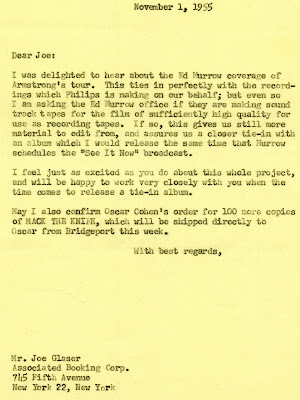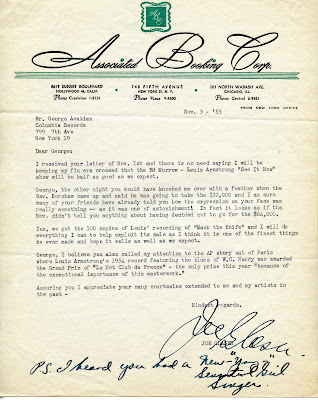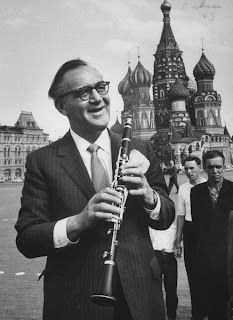
In the Summer of 1962, Phoebe Jacobs asked me if I would be interested in working for Benny Goodman as a press secretary. Well, that was not a field I aspired to, but working for Benny could be interesting. He was getting a band together for his State Department tour of the Soviet Union, so I figured he probably needed someone to handle the press. It really wasn’t something I thought I could do well,but I am a fast learner, so—why not?
As it turned out, I needn’t have worried about my ability to handle the job. On my first day, as I awaited some sort of job description, Benny handed me a $100.000 check made out to the IRS (the income tax people). “Do you think you can learn to write my signature?,” he asked. I told him that it would not be a problem, so he instructed me to practice and put the check in the mail.
I didn’t know it then and there, but that turned out to be my job description. All I ever did while in Benny’s employ was to fake his signature! The Benny Goodman Story was showing in Ghana at the time, so there was a flood of fan letters from there, asking for a signed photo. “I see you in the cinema today and you are so beautiful and white,” read one request that has stuck in my mind.
One day, a request came in from The Famous People’s Eyeglass Museum, I think it was in Houston, but I may be wrong about that. When I asked Benny’s long-time secretary, Muriel Zuckerman, what I should do, she pointed to a closet and told me I would find a pair in large cardboard box. The box was filled with black horn-rimmed glasses. “Benny wore all these?,” I asked. “No,” said the aging secretary, “none of them, but we get this kind of request every once in a while.”
As I mentioned, Benny was forming a band for the tour, so there were daily rehearsals and auditions. One day, a very frustrated Jay (can’t recall his last name), who I think was the road manager, came to the office, plopped himself down in a chair and shook his head. “What’s the problem?,” I asked. “How the hell do you tell Coleman Hawkins that he’s fired?” he said, burying his face in his hands. Needless to say, Benny wasn’t in the office—he had an apartment on an upper floor and rarely came downstairs.
About a month and hundreds of phony autographs later, I decided that there were more important things to be done with my life, so I left.
 |
| Benny and I at a 1982 party celebrating his Stereo Review award. |
BENNY GOODMAN
The seventy-plus King of Swing
is not yet ready to retire
Stereo Review cover story - February, 1982
“Good morning, Chris. It’s good to see you again,” said Benny Goodman, greeting me at the door to his New York apartment. It was a clear October morning, the sharp rays of the autumn sun penetrated the large twenty-first-story windows, deflected to every corner of the brightly decorated living room, and played tag among various objects of art and memorabilia. There was also a glimmer of light in Goodman’s eyes. Could he possibly have remembered me from that one brief introduction singer Jimmy Rushing performed almost eighteen years ago? Of course not, I thought, the King of Swing merely assumed that we had met, and this was his gracious way of covering up a much-publicized absentmindedness. When one reaches Goodman’s stature in life, the right to practice such minor deceptions is a given.

As we seated ourselves by the cold fireplace, I told Goodman that we should, by rights, already have been personally acquainted, for I had spent about two months on his payroll in 1962, working in his office just an elevator ride away from the apartment.“Is that so?” he said, appearing both surprised and amused as he searched my face for something to trigger his memory. But I hastened to add that we had in fact not met during that time. He asked me in what capacity I had worked for him and seemed not at all surprised to hear that my main duty had been to sign his autograph on countless eight-by-ten glossies, some letters, and an occasional album.“Were you good at it?” he asked.“Yes,” I replied immodestly, adding that I had once been a commercial artist, so that capturing the character of his signature had been a breeze. The Goodman eyebrows arched and I quickly assured him that I had not since had any use for my calligraphic skill in that area.
If working for Goodman did not gain me his acquaintance, it did provide me with solid confirmation of his enormous, ongoing popularity. By 1962 bop and other forms of modern jazz had long since put Swing music on the nostalgia shelf, pseudo folk music was front and center, and the Beatles stood in the wings gearing up to change a lot of things around. Yet I must have fulfilled close to a hundred requests for autographs from, for example, Ghana alone, all in all probably signing Goodman’s name more often than I had my own up until then. The letters poured in from all directions, thanks and adulation from some who remembered and others who had just discovered the very distinct and likable sound of Benny Goodman’s music. Few jazz musicians have enjoyed as large and widespread a following, and even fewer have been able to maintain their popularity for as long as Goodman has. Of course, it all came into full flower during the Swing Era of the Thirties, when some jazz artists, for the first and only time, were accorded movie-star status by clamoring fans?but the seeds of Goodman’s fame had been planted long before then, and in not nearly so glamorous a setting.
On May 30, 1909, in a rough Jewish ghetto of Chicago, Benny Goodman became the eighth of eleven children born to a couple who had immigrated from Poland and Lithuania, respectively, some twenty-five years earlier. A tailor whose meager $20-a-week salary left little or no room for even the most modest frills, David Goodman was determined to see that his children availed themselves of every opportunity for advancement. Accordingly, when he learned that a neighborhood synagogue was offering the free loan of musical instruments, plus lessons for a token fee, he took his cue from a neighbor and marched three of his sons over to the temple. “They gave me a clarinet, because I was the smallest,” recalls Goodman, who was nine or ten at the time.“Harry got a tuba, and Freddy a trumpet, it was kind of haphazard, I guess.”
If the casual choice of instrument proved to be perfect, so did the timing: Chicago, in 1919, was experiencing an influx of New Orleans musicians. Such men as King Oliver, Freddie Keppard, and Jimmie Noone were introducing Chicagoans to the exciting polyphonic ensemble playing and syncopated rhythms of a music only recently named jazz, and they were soon to be joined by Johnny Dodds, Baby Dodds, Honoré Dutrey, and Louis Armstrong, artists whose impact on American music Goodman himself would match in a later decade.
But Goodman did not immediately plant himself in the city’s fertile jazz soil. At eleven, he became a member of the sixty-five-piece Hull House Settlement Band, playing a repertoire of popular marches and classical warhorses. The following year he also occasionally paraded with the 124th Regiment Field Artillery Band, a job that netted him five dollars a parade and thus brought him into the ranks of professional musicians. It was during this time that young Goodman began to receive formal training from clarinetist Franz Schoepp, a member of the Chicago Symphony, whose students also included Buster Bailey. Looking back on that formative period, Goodman values most highly the two years spent with Schoepp, a German who viewed life from a nineteenth-century perspective, using only German editions of music books because “pretty soon everything will be in German.”
Herr Schoepp was more on target when he predicted a promising future for his inquisitive pupil. “He did more for me musically than anyone I ever knew,” Goodman acknowledges. “It was my father’s idea that I study music formally, and he took me to him [Schoepp] as soon as he felt I showed some promise.” Was Schoepp interested in jazz? “No, he did not condone it. He was a rigid classical disciplinarian?I started out with a rather wide scope of musical interest.” But, I asked, echoing a common belief, had it not been at the urging of his brother-in-law, record-producer John Hammond, that Goodman later directed his career along a classical bypath? Goodman smiled, “Oh, I don’t think so...no ...I don’t think so. I have, since the early Thirties, had records of the Brahms and Mozart quintets, and I think it’s kind of a natural thing to be drawn toward classical music for the clarinet.” Would he have taken the classical instead of the jazz route if the opportunity had been there? “No, because I had that opportunity,” he says.“I think I was drawn to jazz pretty quickly when I was a youngster, I think it was much easier and more interesting for me at the time.”
Goodman would later preside over the most famous jazz concert of all time, but he nonetheless made his own concert debut in a classical duet. It was a small student affair that took place when he was about ten and already under Schoepp’s wing. “This little girl pianist and I performed a Haydn transcription,” he recalls, “so you see that classical music was not an afterthought.” In early 1920, Goodman took a record that his brother had brought home, and he committed to memory, note for corny note, the Ted Lewis hit When My Baby Smiles at Me. A subsequent performance of the Lewis number earned young Goodman five dollars at a local vaudeville theater, so it may well constitute his first step toward jazz even though Lewis was decidedly a peripheral figure in that music. Among other recordings Goodman studied were some by the Original Dixieland Jazz Band, whose clarinetist, Larry Shields, played in a style that bordered on novelty but which nevertheless contained more jazz substance than Lewis’.
I told Goodman of a book whose author accused him of having stolen his style from Johnny Dodds, “Grand larceny, I suppose,” he said, chuckling at the very thought. As anyone with knowledge of the Dodds and Goodman styles will tell you, the notion is ludicrous. Goodman does acknowledge the influence of others on his style, knowing full well that it would be folly to assert that he, or anyone else, for that matter, had a wholly original way of playing. Influences, of course, come in various forms, and Goodman’s included the bands of Isham Jones, Paul Whiteman, and Roger Wolfe Kahn and the trumpet styles of Louis Armstrong, Bix Beiderbecke, and Red Nichols as well as the styles of some clarinetists. “I was very impressed with Jimmie Noone,” he says, with a bow to a New Orleans jazz man who is said also to have made a deep impression on the French composer Maurice Ravel, “and Leon Rappolo was also awfully good, though I never heard him in person.” Such admiration has left traces of Noone and Rappolo in the Goodman style, but only traces?the unique Goodman approach is much in evidence even on some of the earliest recordings.
To get an idea of how prolific a recording artist Goodman has been, consider the fact that what is generally regarded as his “early” output exceeds the total lifetime recorded efforts of most artists. If one’s collection consisted of every item in the Benny Goodman discography and nothing else, its size would be most impressive. Goodman was seventeen when he launched his recording career under the leadership of bandleader Ben Pollack. It was an inauspicious start: the first three sides?made for Victor in September 1926?were never released, nor were the next efforts, six or seven Edison cylinders (of all things) recorded in the home of trumpeter Earl Baker’s mother. Those who have heard these crude, pioneer home recordings claim to be able to identify Goodman’s clarinet even through the surface noise.
Goodman’s first commercially released side was When I First Met Mary, made for Victor in December 1926, with Ben Pollack and His Californians, a thirteen-piece group that included Goodman’s brother Harry, Glenn Miller, and composer Victor Young. All these early recordings were made in Chicago, but the Goodman-Pollack association actually began the year before, at the Venice Ballroom in Los Angeles. Benny was then sixteen years old. Joining Pollack in California was the first significant step into a musical world Goodman would soon dominate, but he took it less for musical reasons than to experience the much-publicized glamour of California.
What he found did not glitter as advertised. “When I looked around and saw how sleazy the place was,” he says, “I began to wonder why I had come, but all wasn’t lost, because the band was awfully good.” That it was, but it would become even better as more budding stars came aboard. Goodman played with Pollack off and on for three years, moving during this time to New York; there he immersed himself in studio work, building up a reputation as he broadcast and recorded with such stars as Gene Austin, Sammy Fain, Lee Morse, Ethel Waters, Ruth Etting, and even Ted Lewis. “A lot of that work was boring as hell,” he later admitted, “so when the opportunity to play some good music came along, one grabbed it.” By sheer coincidence, Goodman participated in a transition that saw the greatest of all blues singers exit and the Swing Era’s most important vocalist make her entrance: he is barely heard on Gimme a Pigfoot and a Bottle of Beer, from Bessie Smith’s famous swan song date, and two days later, ironically, in the same Columbia studio, it is his session that marks the debut of a young, slightly nervous Billie Holiday.
By the end of 1933, Goodman had made numerous recordings as leader, including some produced by Hammond specifically for the growing European jazz market. He also occasionally led a band outside the studio, but these bands lasted only as long as the jobs they were designed for (one was backing singer Russ Columbo), and Goodman found that lending one’s name to a band did not in itself guarantee musical freedom. What he needed and soon began to seek was an orchestra he could keep long enough to give an identity to, a smooth running swing machine that would embody the very essence of hot jazz. The concept was not by any means new; Duke Ellington and Fletcher Henderson had created such bands in the previous decade, but?with the exception of the Casa Loma Band, which had some of the qualities Goodman desired?such organizations were black and therefore victims of a color barrier that had often stunted the growth of American music. This barrier affected white musicians too, for it was impossible to pretend that it did not exist.
Goodman began to get it together around 1934, when he enlisted the aid of John Hammond and set out to form an orchestra that would provide him with the rhythmic drive and fire of bands led by his esteemed black colleagues. Hammond’s background was diametrically opposed to Goodman’s: his mother was a Vanderbilt, his family home a Manhattan mansion staffed by sixteen servants and boasting a ballroom seating 250 people. But the twenty-three-year-old Hammond shared Goodman’s enthusiasm for jazz, and the combination of that interest and wealth paved the way to powerful connections at the business end of the music industry. “Benny had been working steadily,” Hammond recalls, “but the Depression was getting worse, so even musicians of Benny’s skill began having a hard time. I told him I’d do everything I could to find the right musicians, and soon the band began to take shape, even though there was no steady work to be had.” At the suggestion of the concert pianist Oscar Levant, Broadway producer Billy Rose auditioned and hired the new Goodman band as one of two alternating orchestras at his new supper club, Billy Rose’s Music Theatre (the other band was led by Harold Arlen’s brother Jerry). The engagement was cut short after six weeks, some say because Rose was squeezed out by his associates. But Hammond offers a more interesting explanation, citing fierce competition from around the corner: a mob-operated club featuring the bands of Ben Pollack and Don Redman, better food?and a naked girl in a fish bowl.
It was around this time that Goodman met Willard Alexander, a young booking agent with the Music Corporation of America. MCA was the country’s largest booking organization, and it was inconsistent with its past policies to handle an untested, uncommercial band such as Goodman’s, but Alexander was a believer not easily discouraged. He sent the band to audition for a new NBC network radio program called Let’s Dance. The three-hour weekly broadcast, coincidentally sponsored by another NBC, the National Biscuit Company?also featured the more popular fare of the Xavier Cugat and Kel Murray bands, and Goodman’s band was chosen over the competition by a narrow one-vote margin.
The broadcasts ran from December 1, 1934, to the following May 25, but even with national exposure the band had to accept such additional jobs as playing for an Elks Lodge. Following the last broadcast, Alexander booked the band into the Grill Room of New York’s Roosevelt Hotel, but this was the traditional winter home of Guy Lombardo and His Royal Canadians, and neither patrons nor hotel management took well to the change of pace Goodman and his men represented.“They were given their two-weeks’ notice the night they opened,” Alexander recalled many years later. Still undeterred by the band’s lack of acceptance, Alexander arranged a tour that was to last almost a year.
But before leaving New York, Goodman established another milestone in his career and, indeed, in the history of jazz: he made the first Benny Goodman Trio recordings. These sides—eight in all, with Krupa and pianist Teddy Wilson—heralded a long and successful series of recordings and live performances featuring small groups playing that has aptly been referred to as chamber jazz. It began rather informally, when the three?all guests of xylophonist Red Norvo and his wife, singer Mildred Bailey, decided to entertain at a party. Later, with the addition of Lionel Hampton, the trio would become a quartet, and, later still, the art of cohesive small-band swing would reach perfection in a series of extraordinary Goodman Sextet performances.
Getting back to early 1935, Goodman’s future did not look terribly gloomy. He was, after all, working at a time when many Americans were not, and he not only had his own band but also a recording contract (with Victor). But as the tour proceeded across the country, heading in the general direction of the West Coast, the band’s morale gradually diminished, hitting rock bottom when the customers of Denver’s Elitch’s Garden demanded their money back and had to be appeased with waltzes. Goodman later described that as the most humiliating experience of his career, and by the time he reached California he had developed a devil-may-care attitude that prompted him to pull out all the stops, unleash the band’s swing power, and let the chips fall where they may. They fell on surprisingly enthusiastic ears when a one-night stand in Oakland turned into a small triumph, but the real turning point came right after that, on August 21, at the famous Palomar Ballroom in Hollywood, “We decided to shoot the works with our best things like Sugar Foot Stomp, Sometimes I’m Happy, and others,” Goodman later recalled.
“Actually, we were almost scared to play. But from the moment I kicked them off, the boys dug in with some of the best playing I’d heard since we left New York. I don’t know what it was, but the crowd went wild, and then, boom! That was the real beginning.” Goodman’s strict training had paid off. The discipline he had learned from Franz Schoepp did not always make him popular with his musicians, but he recalls that in those days his quest for perfection was usually shared by all the band members. “Musicians don’t want to rehearse any more,” he laments, “and they don’t seem to care how they present themselves, visually, to the public. I always cared a great deal, hell, we all did, we all had a sense of style. There was a certain elegance one strove for in those days. One dressed correctly, with shiny shoes, shiny instruments, and even the music had to have a certain sparkle. There was something called an individual tone by which you could identify all the top players, you just had to hear one note and you knew it was Louis, Lester, Sidney Bechet, or Johnny Dodds.” Or Benny Goodman, I added. “Yes, I suppose,” he replied with deliberate modesty.
Most leaders would have been totally discouraged by the reception the band got throughout most of that cross-country trek, but Goodman was stubbornly determined to see it through. Had he given up before reaching the Palomar, remarked Gene Krupa in a well-meant if not well-constructed sentence. “there’s little doubt but what many of us who have enjoyed success, prominence, and considerable financial reward since the late 1930’s would have ever attained these heights.”
Shortly after that historic night at the Palomar, Gene Krupa dubbed his boss “The King of Swing,” but he surely could not have foreseen how long and successful the King’s reign would be. Goodman did not, of course, singlehandedly create the Swing Era, but he did provide the spark that set it all off. The number of fans grew almost exponentially until the whole country seemed to be singing his tune and the whole music industry was taking its cue from his downbeat.
Goodman’s contribution was sociological as well as musical, for not only did he set the jitterbugs in motion, he took a whack at the racial barrier in the entertainment world by hiring such black musicians as Teddy Wilson, Lionel Hampton, and the remarkable Charlie Christian. This went against the grain of a music industry seemingly bent on uniting the races only when the public wasn’t looking, but it deeply enriched his band. There were also fresh white voices, and the band grew better as lesser talents were replaced by men whose names would become household words: Harry James, Ziggy Elman, Jess Stacy. And as the band grew better, the cheers grew louder. By 1937, the Swing Era was in full flower and the inevitable happened: jazz made its way onto the stage of New York’s Carnegie Hall. Would it work? There was certainly no one better equipped than the King of Swing to test the feasibility of presenting jazz in such a hallowed setting.
The test took place January 16, 1938, and Goodman brought out the heavy artillery. Besides his own band and small groups, he presented an eminent contingent from the Basie orchestra, including the Count himself (with that superb rhythm section), Lester Young, and Buck Clayton. From the Duke Ellington orchestra he borrowed Cootie Williams, Johnny Hodges, and Harry Carney, and, as if that were not enough, the producer was Sol Hurok. Still, Goodman was not sure he could pull it off, so he asked comedienne Beatrice Lillie to come in and help “warm up the audience with a few jokes,” an invitation she wisely declined. The concert was an unqualified success. In fact, it made history. Twelve years later a private recording of it became a two-record Columbia set that still remains in the catalog, as any recording of such historical and musical significance should.
When asked how long he wanted the concert’s intermission to be, Goodman is said to have replied, “I dunno, how much does Toscanini have?” It was the sort of line Hollywood would milk to death in dozens of jive-longhair musicals, one of which was a 1956 horror called The Benny Goodman Story, starring Steve Allen in the title role. I asked the real Benny Goodman how he felt about the Hollywood version of his life. “Well, forget it!” he said, laughing as if I had just told a joke. “I didn’t like a good deal of it. I don’t think I’ve seen it more than once or twice; it’s a picture I’m not very intimate with. You know, it’s terribly difficult to make a dramatic story out of a musician’s life when nothing really terribly dramatic has happened. It was different in the case of Glenn Miller, he got lost, you know.” The Goodman film was rather um . . . bland, I suggested. “It sure was: The Billie Holiday film (Lady Sings the Blues) came out rather well, whether you liked it or not. I mean, it was a commercial success, with all the drinking and drugs and things, it makes more of a story.”
A classical musician plunging into a mad boogie woogie remains Hollywood’s idea of the kind of thing people want to see, and the reverse situation is not one they care to explore. Goodman wishes they had shown his classical side instead of dwelling on the old highbrows-get-down theme. When we met, he had just returned from England’s Aldeburgh Festival, where he performed Mozart’s Quintet for Clarinet and Strings, K. 581, with the Amadeus String Quartet, and Brahms’ Sonata, Op. 120, No. 1, with pianist Clifford Curzon. “And then we had a jazz group,” he adds, smiling.
As he approaches his mid-seventies, has he any plans to retire? “No.” comes the quick reply. “I think a lot of people nowadays feel as if they’re in good shape and they might as well do what they can do?you give a lot of people pleasure, and that’s always desirable.” Indeed, and if Mr. Goodman’s high demands have given some of his musicians an ache over the years, it is but a fleeting pang compared with the immeasurable joy his music continues to give people from Ghana to Galveston.
And so, though Goodman is by no means retired, he is certainly in the rarified category of Elder Statesmen of Jazz. His success over the years has been enormous, his contribution to American music prodigious, and it is only fair that he now reap the honors due a long and rich career. In many ways he is yet one more exemplar of the American dream. The son of immigrants, he grew to be a master of an indigenous American music. Born to poverty, he became wealthy. Classically trained, he was both individual and innovative in jazz and then built a distinguished reputation as a classical soloist as well. Himself a Jew, he was a powerful force in demolishing the color barrier in music, allowing blacks and whites to occupy the same stage at the same time and to play the same music, judged only by how well they could play. If there is living proof that democracy works in music. Benny Goodman is it.

 Fortunately, the concert eventually landed in the capable hands of Swedish mastering engineer Björn Almstedt. His work is heard on the Jasmine label's 2-CD set (pictured on the left) and it is superb. Almstedt's focus was on the music and not on coughs and sneezes from the second balcony, so, for the first time, this great concert really comes alive.
Fortunately, the concert eventually landed in the capable hands of Swedish mastering engineer Björn Almstedt. His work is heard on the Jasmine label's 2-CD set (pictured on the left) and it is superb. Almstedt's focus was on the music and not on coughs and sneezes from the second balcony, so, for the first time, this great concert really comes alive.





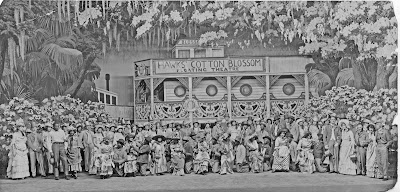.jpg)
+Ivan+Harold+Browning,+Marian+Anderson,+John+Payne,+Haroldine+Browning,+Alberta.jpg)



.jpg)

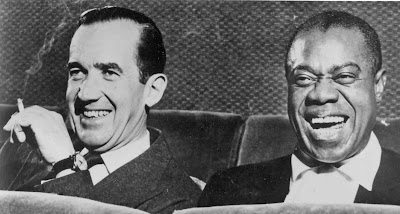.jpg)
